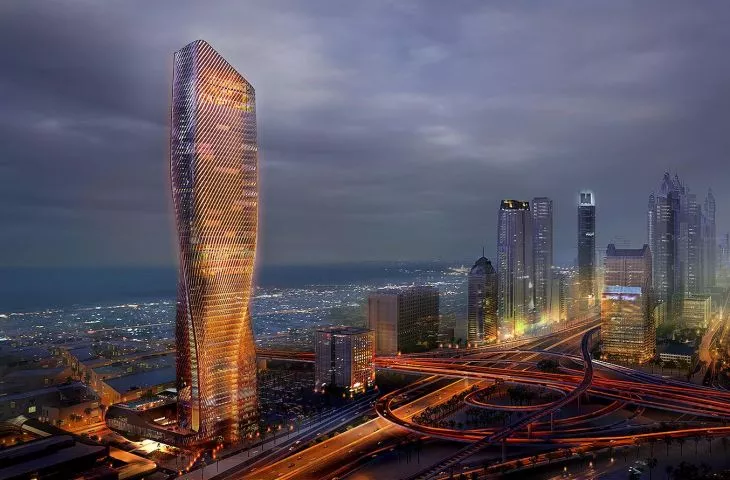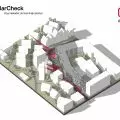The article appeared in A&B 12'2020
Artificial Intelligence (AI) is an issue that is increasingly touching our lives. Even if we don't fully understand what it is, and we don't always realize how momentous this technological achievement is. What impact can it have on the architectural design process? And how might it affect the architectural profession?
The ubiquity of AI
Algorithms collectively referred to as AI are used in the design of autonomous cars, military drones or personal assistants like Siri from Apple or Amazon's Alexa. Almost imperceptibly, AI has become part of our lives, and today it is no longer strange for anyone to speak to their phones and they respond with meaning.
Among other things, AI is based on algorithms that optimize the outcome for a goal that is hard to define - like winning a chess game. When a computer created by IBM Deep Blue defeated world chess champion Garry Kasparov on May 11, 1997, observers realized that an era had come to an end. Today, chess tournaments search for "overly creative" moves that betray the technological doping of players, and top-level competition takes place between algorithms. In 2018, a tool authored by engineers at DeepMind (owned by Google) - AlphaZero - learned the rules of the game and mastered winning techniques in four hours just to beat a previous version of the world's best machine.
Let these stories be a warning to those who see in human creativity an impregnable bastion for AI algorithms.
Many industries are using AI algorithms to automate repetitive tasks, increase the speed at which they are performed or find patterns in large amounts of data. A breakthrough discovery using AI is a project by San Francisco-based Atomwise. An anti-epidemiological AI model designed by the company in 2015 and equipped with access to the computing power of supercomputers in a pilot program found an effective vaccine variant for the Ebola virus within a day. The same process conducted by scientists would take several years. In our opinion, the architectural design process could also be facilitated by tools of this type.
public space insolation analysis for 33 King William St, Candlewick, London
From the authors' archives, © Designbotic
why technology for architecture?
Ben van Berkel, founder of UNStudio, says the digital revolution is driving change in almost every sphere of our lives, except the built environment. In his view, it's time for architecture to make up for this neglect. The company he founded, UNSense, is dedicated to studying the impact and implementation of new technologies in architectural design, urban planning and related fields.
The need to reconcile the many, often disparate, factors influencing design in the age of climate change is forcing the need to think holistically about buildings and their internal systems. The pursuit of energy optimization, which is costly, but also related to the broader well-being of users, has become a daily reality for "high-end" design offices.
Building certification under LEED, BREEAM, WELL or the Polish Green House system requires architects to think about solar exposure, potential solar gains, user comfort in terms of urban interior proportions, wind speed or acoustics.
In office or public spaces, the thermal comfort level of users is being studied, and in lecture halls, lighting can be selected to provide the best possible focus for the audience.
Larger urban assumptions should be analyzed with advanced tools for their impact on pedestrian and vehicular traffic, as well as for the visibility of urban landmarks (for example, space syntax).
From practice and conversations with other architects, we know that most of the above-mentioned analyses in Polish projects are never performed, and if studios commission them, it usually takes place at the final stage of the project, to "prove", as it were, that the conditions of the chosen certification have been met.
A more sensible way to design is to introduce analytical tools already in the preliminary design phases. Thus, their results can become an additional parameter shaping the form and layout of objects. In such a situation, it is possible to talk about a holistic approach to design, and its effects will be felt not only for future users, but also for the investor's "pocket".
However, the amount of information that results from simulations and analyses can be difficult for humans to interpret. They are often based on one or two spatial alternatives. Using the computing power of modern processors can allow hundreds of possible solutions to be compared simultaneously. The limitation is the efficiency of designers who, for reasons of time and economy, are unable to generate and compare a large number of alternative solutions.
A set of optimal spatial solutions generated by the created AI-based tool
From the authors' archive, © Designbotic
AI in architecture
Sidewalk Labs (owned by Alphabet - Google's parent company), which describes itself as a company of urban innovations, recently made a name for itself by unveiling Delve, an AI-based urban design tool.
In its first version, the software appears to rely mainly on optimizing parameters that are relatively easy to describe mathematically, and the results of the program's work are comparable to preliminary absorption analyses of parcels of land intended to give an idea of possible ways to obtain the maximum saleable floor area while meeting the set parameters.
Similar functionality is presented by the software of Singaporean company Digital Blue Foam. However, the tool does not assume full automation of the design process, but is an "extension of the designer's intelligence", which indicates the possible directions of the concept, while the task of the program is to select the optimal variant of spatial solutions. In this case, we can talk about the cooperation of the algorithm and the architect. The proposals of Sidewalk Labs and Digital Blue Foam present two directions of development of architectural software: fully automating the design process and actively supporting the architect.
While obtaining a number of possible solutions for the mathematically defined task of obtaining maximum usable space on a plot can be useful in preliminary analyses, it is difficult to admit that such a process replaces an experienced designer.
Designbotic, a Polish company that is the first entity in the country in the arch tech (from: architectural technology) industry, has undertaken the development of an AI-based tool that will not only take into account easily definable limiting parameters (such as footprint, height, intensity), but also bring into the process the complex analysis required in building certification. In addition, the goal of the ongoing research is to include many non-definable parameters, such as designer taste, composition or aesthetics, in the form generation process. We estimate that a similar goal guides the developers of Delve and other tools of this type.
A screenshot from Delve - a list of parameters and one of the most optimal spatial results
From the Authors archive, © Sidewalk Labs
The possible impact of AI on the architectural profession
Kostas Terzidis, in his book "Algorithmic architecture," points out that the use of algorithms to support the design process will make the architect a kind of cyborg, who, together with his virtual partner, will be able to make decisions previously impossible.
The emergence of a symbiosis between a computer program and a human designer is one possible variant of the application of Artificial Intelligence in the architectural design process. Such a relationship could look like the "breeding" of virtual buildings, which are subjected to the evaluation of the program user in terms of aesthetics, composition and other parameters that are difficult to enter as part of the algorithm's evaluation function. In such a situation, the designer's taste would become part of the optimization process, i.e. the results of the program would be different depending on who uses it.
It should be taken into account that we are dealing with optimization of the form in terms of many parameters, the dependencies of which we will not be able to understand. The question of legal responsibility for the project remains open. As is the question of authorship - will the author be the user of the program, its creator or the algorithm itself?
Another scenario is for AI to attain the level of human intelligence and make algorithmic entities completely independent of human designers. Such a possibility for architects sounds quite like the scenario of the next episode of the TV series "Black Mirror," but according to many authors it is not at all improbable. An interesting voice in the discussion about AI is raised by Yuval Noah Harari in his book "Homo Deus" - in his opinion, consciousness is not necessary for the existence of intelligence. For architects facing competition from AI, this could mean that they will be competing with an entity that mechanically solves the spatial task of design.
What about the spirit of the place? What about the fact that people design for people?
Are architects really as indispensable as they think they are? If so, perhaps there is nothing to fear.
***
Trying to answer the perverse title question is incredibly difficult and unfortunately doomed to failure, as technological developments have already played tricks more than once on those who wanted to predict the future. However, we are convinced that Artificial Intelligence will have a growing impact on the architectural design process, and the fact that technological giants are involved can only accelerate it.
Jakub BLADOWSKI, Kacper RADZISZEWSKI
Illustrations: authors archive
Jakub BLADOWSKI - co-founder of Designbotic. In 2008 he graduated from the Faculty of Architecture at the Gdansk University of Technology, and in 2013 he defended his dissertation "Application of genetic algorithms in architectural design" at the same faculty. He currently works as an assistant professor in the Department of Urban and Regional Planning at the Faculty of Architecture, Gdansk University of Technology, and runs Roark Studio, an architectural studio established in Sopot in 2015. He studies the impact of urban factors on the health and well-being of users.
Kacper RADZISZEWSKI - co-founder of Designbotic. Graduate and teaching and researcher at the Faculty of Architecture, Gdansk University of Technology. Founder of the Foundation for Contemporary Architecture. Conducts research in Artificial Intelligence and the use of algorithms in the field of architectural design. Co-author of the scientific monograph "Contemporary Parametric Design in Architecture". Participant of international scientific conferences. Author of scientific publications in the field of application of programming, optimization algorithms and machine learning in the field of architecture.


































